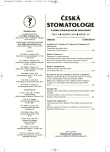Crowding of Teeth in Lower Jaw from a Prehistoric Locality Roonka in South Australia
Authors:
M. Prokopec
Authors‘ workplace:
Státní zdravotní ústav, Praha
Published in:
Česká stomatologie / Praktické zubní lékařství, ročník 107, 2007, 6, s. 161-164
Overview
When analyzing human remains from Roonka the author was struck by the frequent incidence of crowded teeth in the mandibles (round 25 per cent). This contradicts statements in the literature according to which hunters and gatherers have lower incidence of tooth crowding in comparison with nomads and agriculturists. He finds the explanation in stress due to chewing tough food from early age. The advancing Europeization will probably lead to the diminishing of this stress but also to the diminishing of the lower jaw. According to the theory that the lower jaw diminished independently of size of the teeth and faster than the teeth, an increase of this anomaly in the contemporary aboriginal population may be expected.
Key words:
paleopathology - archaeological excavations - population of hunters and gatherers
Labels
Maxillofacial surgery Orthodontics Dental medicineArticle was published in
Czech Dental Journal

2007 Issue 6
Most read in this issue
- Attrition, Abrasion, Corrosion and Abfraction New Overview of Superficial Teeth Lesions
- Stress as Etiological Factor in Diseases of Mandibular Joint
- Use of Buccal Fat Pad
- Cytotoxicity of Dental Alloys
